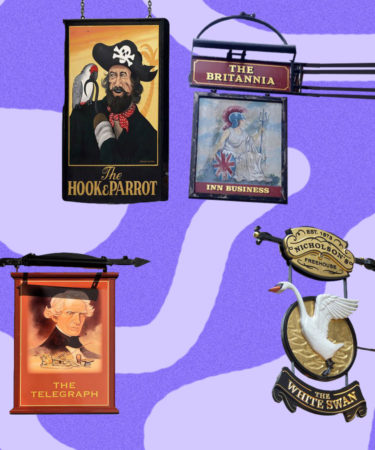Public houses have played a significant role in British culture for centuries. These days, there are nearly 40,000 pubs scattered across the cities and villages of the U.K., many of them boasting unique names and decorative signs with hand-painted illustrations.
Beyond providing the lubrication that helps keep Britain’s social scene running smoothly, pubs — and their signage — offer a glimpse into the country’s past, harking back to times when foreigners invaded British soil, kings ruled by decree, and a large majority of the British population could not read or write.
After the Romans invaded Britain in 43 A.D., they brought with them a tradition of placing vine leaves outside of tabernae, centers of commerce that also served as drinking establishments. The leaves were used to signal to potential customers that wine was sold within. After finding that vines were not readily available in Britain, the Romans used small bushes and other foliage as replacements.
It wasn’t until the 12th century that the colorful pub signs we see today became the norm. At that time in British history, a large majority of the population was illiterate. Similarly to the Romans, pub owners used painted symbols to signal that liquid nourishment could be found within.
Pub owners took no chances when advertising their businesses. The signs during this time were often “simple representations of tankards, hops and other brewing-related paraphernalia used to inform passersby that the establishment sold ale,” writes James Hunt in a 2015 article for Mental Floss.
In 1393, King Richard II ordered every inn and pub to display his personal emblem, a white hart (“hart” was the popular term for a stag at the time). The new law made it easy for officers known as ale-conners — a highly respected position that involved tasting ales for quality — to identify premises serving beer. Punishment for noncompliance was steep. Failure to hang a sign resulted in the forfeiture of the establishment’s ale. It wasn’t long before every pub in England bore a sign outside its door.
As time went on, public houses cemented their position in the center of Britain’s social culture. Despite being inspired by the traditions of conquering armies and later bearing the uniform mark of a king, pub signs would eventually become artful and eclectic signifiers of a shared gathering place.
With the number of pubs on the rise for the first time in a decade, it’s clear that these establishments are going to continue serving the British community for years to come — while also offering a little history lesson for anyone paying attention to the sign outside the door.
